
|


His Legacy
|

|
|

|

Newton's Dark Secrets homepage
|
| |

|
| |
Sir Isaac Newton's accomplishments border on the uncanny, as does
his image in the world of science. As the historian Mordechai
Feingold has written, "With time, the historical Newton receded into
the background, overshadowed by the very legacy he helped create.
Newton thus metamorphosed into science personified." So what is that
legacy? What were those accomplishments? Here, familiarize yourself
with Newton's greatest contributions.—Peter Tyson
|
|

|
|
|
Invented the reflecting telescope
The standard telescope of Newton's time, the refracting telescope,
was not ideal. Its glass lenses focused the different colors
inherent in light at different distances. This resulted, at the
edges of any bright objects seen through the telescope, in colored
fringes that rendered those objects slightly out of focus. Newton
solved the "chromatic aberration" problem by using mirrors instead
of lenses. His original reflecting telescope, which he built himself
in 1668, was just six inches long. This modest device not only
eliminated the colored fringes but magnified whatever it focused on
by 40 times, which, as Newton noted at the time, "is more than any 6
foote Tube can do." After presenting his scope to the Royal Society,
the then-unknown Newton was proposed for membership; he later served
as its president for 24 years, until his death in 1727.
|
|

|
A replica of the six-inch reflecting telescope that
Newton presented to the Royal Society in 1671

|
|
|
|
|
Proposed new theory of light and color
Not long after he donated his telescope to the Royal Society, Newton
delivered a paper to that august body about his novel theory of
light and colors. Using prisms and his usual very exacting
experimental technique, Newton had discovered that sunlight is
comprised of all the colors of the rainbow, which could not only be
separated but recombined into white light. "[T]he most surprising
and wonderful composition was that of Whiteness," he wrote. "I have
often with Admiration beheld that all the Colours of the Prisme
being made to converge, and thereby to be again mixed ... reproduced
light, intirely [sic] and perfectly white." Though he made
his experiments on light as early as 1666, when he was only 24 years
old, he didn't publish his classic
Opticks, which summarized his findings on light and color,
until 1704.
|
|
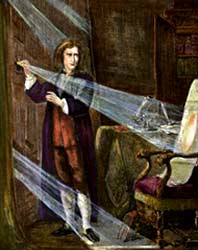
|
"Newton Investigating Light," from
The Illustrated London News, June 4, 1870

|
|
|
|
|
Discovered calculus
When Newton began to muse on the problem of the motion of the
planets and what kept them in their orbits around the sun, he
realized that the mathematics of the day weren't sufficient to the
task. Properties such as direction and speed, by their very nature,
were in a continuous state of flux, constantly changing with time
and exhibiting varying rates of change. So he invented a new branch
of mathematics, which he called the fluxions (later known as
calculus). Calculus allowed him to draw tangents to curves,
determine the lengths of curves, and solve other problems that
classical geometry could not help him solve. Interestingly, Newton's
masterwork, the Principia, doesn't include the calculus in
the form that he'd invented years before, simply because he hadn't
yet published anything about it. But he did combine related methods
with a very high level of classical geometry, making no attempt to
simplify it for his readers. The reason was, he said, "to avoid
being baited by little Smatterers in Mathematicks."
|
|

|
The first page of Newton's "How to Draw Tangents to
Mechanicall Lines" (November 8, 1665), from his "Waste
Book" manuscript

|
|
|
|
|
Developed three laws of motion
Newton's Principia is difficult to comprehend on two levels,
even for experts: in its original form, it is written in Latin, and
it uses very challenging mathematics. Yet one thing that comes out
very simply and very clearly to all is his three laws of motion:
Law of inertia: Every object persists in its state of rest or
uniform motion in a straight line unless it is compelled to change
that state by forces impressed upon it.
Law of acceleration: Force is equal to the change in momentum
(mV) per change in time. For a constant mass, force equals mass
times acceleration, F = ma.
Law of action and reaction: For every action, there is an
equal and opposite reaction.
To these Newton added, in the Principia, two general
principles of space and time, many careful explanations, and much
else besides. All of this went into his classic explanation of how
the universe works, otherwise known as Newtonian mechanics.
(Mechanics developed into a branch of physical science that deals
with energy and forces and their effect on bodies.).
|
|
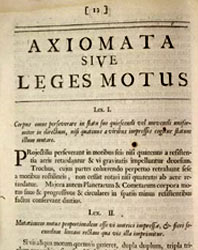
|
Newton's first and second laws of motion, in Latin, as
they appear in the original 1687 edition of the
Principia

|
|
|
|
|
Devised law of universal gravitation
Newton said shortly before his death that it was seeing an apple
fall in his mother's garden that set him thinking "that the power of
gravity ... was not limited to a certain distance from the earth but
that this power must extend much farther than was usually thought.
Why not as high as the moon ... and if so that must influence her
motion and perhaps retain her in her orbit." This brainstorm (which
some scholars suspect Newton may have invented late in life)
ultimately led to his law of universal gravitation. The law says
that all particles of matter in the universe attract every other
particle, that gravitational attraction is a property of all matter.
The law explained many things, from the orbits of the planets around
the sun to the influence of the moon and sun on the tides. And it
held sway as the accepted description of terrestrial and celestial
mechanics for almost 200 years—until Einstein came along and
rocked the boat with relativity.
|
|
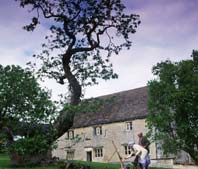
|
As an old man Newton claimed the idea of universal
gravitation came to him while watching an apple fall in
the garden of his mother's house at Woolsthorpe (above,
as it appears today).

|
|
|
|
|
Advanced early modern chemistry
Newton spent untold hours of his life practicing alchemy. Like other
alchemists, he sought to turn base metals into gold, find a
universal cure for disease, and secure the elixir of life, which
promised perpetual youth and eternal life. In his garden shed
outside his rooms at Trinity College, Cambridge, in the midst of
phials and furnaces, mortars and pestles, Newton pored over ancient
texts and performed endless experiments. Yet while he never found
what he and other alchemists sought, and while he only published one
short paper that grew out of his alchemical experiments (a two-page
speculation on acids), his work was not for naught. As the historian
Jed Buchwald has said, "As historians have shown in the last several
decades, there was a much more profound element to the practice of
alchemy which really makes it deserving of being called early modern
chemistry." Through his meticulous efforts, Newton greatly furthered
the practice and techniques of chemical science.
|
|
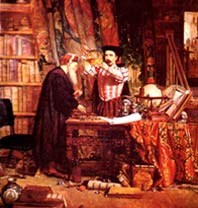
|
The work of alchemists, depicted here in a painting by
the 19th-century artist William Fettes Douglas, helped
lay the groundwork for modern chemistry.

|
|
|
|
|
Became father of modern science
Newton essentially invented many elements of the modern scientific
method. His paper on the properties of light that he presented to
the Royal Society in the early 1670s shows all the hallmarks of the
method he would use throughout his long life: conducting experiments
and taking very careful notes on the results; making measurements;
conducting further experiments that grew out of the initial ones;
formulating a theory, then creating yet further experiments to test
it; and finally, painstakingly describing the entire process so that
other scientists could replicate every step of the way. This method
governs how all science is conducted today. Newton once famously
said, "If I have seen further it is by standing on the shoulders of
Giants." Many scientists today would argue that the greatest Giant
of all in the world of science was Isaac Newton himself.
|
|
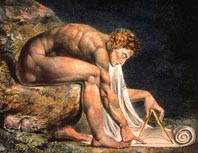
|
"Newton," painted by William Blake in 1795

|
|
|
| |
|
|


|

|
| |
|
|
|

